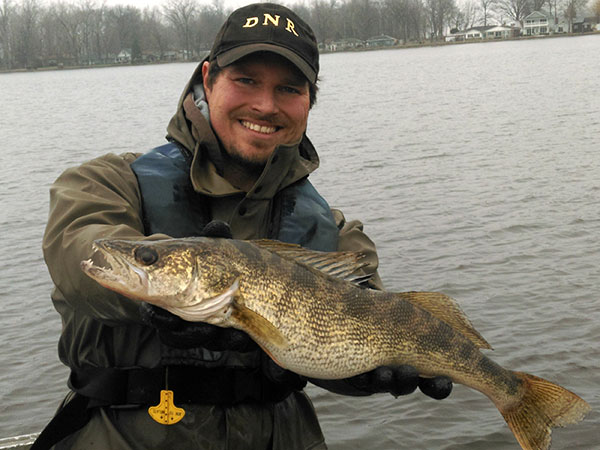By Louie Stout
 Indiana biologist Jamie Pejza shows off a Lake of Woods walleye netted during survey.The St. Joseph River isn’t the only burgeoning walleye fishery on South Bend’s doorstep.
Indiana biologist Jamie Pejza shows off a Lake of Woods walleye netted during survey.The St. Joseph River isn’t the only burgeoning walleye fishery on South Bend’s doorstep.
Indiana biologists say a pretty good one continues to show promise at Lake of the Woods in Bremen.
Biologist Tom Bacula spent a few days last month sampling the lake’s walleye population with a netting project and came away pretty satisfied.
“I am pretty happy with the catch of 15- to 18-inch walleyes we saw,” said Bacula. “They looked very healthy and had great color. We didn’t get any of the giants I’ve heard anglers talk about, but some nice keeper fish.”
The DNR gang set fine mesh traps on sand bars in water 5 to 7 feet deep then checked them daily.
Their work also produces some other surprises, like multiple bluegill measuring 9-plus-inches, crappies up to 14 inches, a ton of white bass, several big channel ‘cats and a few bass.
“I’m not going to say we got a ton of bluegill, and we didn’t get many small ones, but a fair number of big ‘gills,” Bacula explained, who noted that the water temperature was 46 to 50 degrees during the work. “We hear bluegill fishing is tough during the summer, but we came across some nice ones up shallow.”
The big catfish weren’t too big of a surprise since an ice fishing derby there last winter produced a lot of nice channel cats for anglers who were fishing for other species. That’s a pretty good indication of a healthy catfish population.
Bacula’s team collected 168 walleyes ranging from 9.6 to 24.4 inches during their week of work, which was conducted under adverse weather conditions. The majority of the walleyes were males although 23 females between 15 and 24 inches were captured, recorded and released.
“We were surprised to collect two males over 20 inches since most males tend to run smaller.
Lake of the Woods is one of the few Indiana lakes that get stocked annually with 2-inch walleyes in the spring. The state is converting most of its walleye waters to larger fall fingerlings, but the little guys seem to be doing fine there.
“It’s not a big stocking (20,800 per year), but it’s doing the job,” said Bacula. “We used to stock a lot more but we weren’t getting the kind of fishery that we’re getting now. We seem to have a good balance with what we’re doing.”
This is all good news for a fishery that has a history as nemesis for fish managers. The lake has a large population of gizzard shad and white bass. It is suspected that both were stocked illegally several years ago.
While some anglers may think shad are the key forage for growing big healthy bass, they wind up being a bigger detriment in northern waters. Those that don’t get eaten grow to a size too large for most game species and wind up competing and crowding more desirable species, especially panfish.
White bass are considered a gamefish, yet they too proliferate out of control. That’s one reason why bluegill and perch fishing has suffered in the 416-acre Marshall County lake.
Turbidity is another issue. Because of runoff and other environmental factors, Lake of Woods takes on a brownish look most of the year. That limits light penetration and vegetation growth, therefore the lake lacks the habitat found in most natural waters.
But thanks to the walleyes and the catfish, things are looking up right now.
“We’ll be going back in the middle of June for a standard survey to look at all the species,” said Bacula. “That will give us a better idea as to how the bluegill and bass are doing.”





